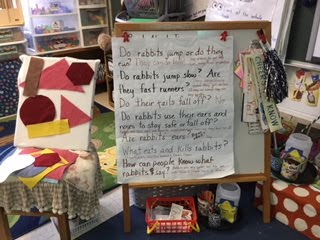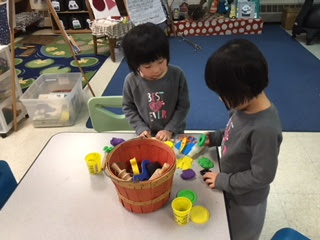 |
| Chalk and beach stones make for creativity! |
 |
| Children work together to create this mandala. We talked about what it looked like, a snail, a tornado, or what have you? |

 |
| A student draws a picture of an animal that interests her based on a text. |
 |
| Children draw about an animal of interest and then write their observations. |
 |
| We are fortunate to own quite a few informational texts about animals. |
 |
| Children have the benefit of alphabet strips and the word wall to help them with their writing. |
 |
| Students look to the word wall to help with the letter/sound connection. |
 |
| This student drew her picture of a cat, and then wrote about what she noticed. The writing is top to bottom and evidences prewriting skills. |





 |
| Friends playing with the shadow puppet theaters. |
 |
| Construction is the theme in the Sand/Water table this week. |
 |
| Due to the use of real needles, children are learning to sew two at a time. We're using embroidery thread and felt to create small pillows for the first project. |
 |
| Play-doh is always a lot of fun! |
 |
| Ms. Reynolds, a volunteer with Joshua's Trust, taught us how to use a compass. |
 |
| We learned about North, East, South and West. |
 |
| The direction of the trail head will be important to know to determine our bearings. This will also be necessary when we draw trail maps for the school. |
 |
| Pointing west means east is behind us. Look at the shadow. |
 |
| Compasses were attached to child friendly sized lids and made into necklaces. |
 |
| Independence is key. |
 |
| Parent volunteers also helped with using the new binoculars. We were looking for squirrel dreys up high and rabbit tracks down low. |
 |
| Children waited their turn for the binoculars. |

 |
| Coyote scat. |
 |
| More scat. |




 |
| Special thanks to Ms. Reynolds and Mrs. Limberg for their support today! |